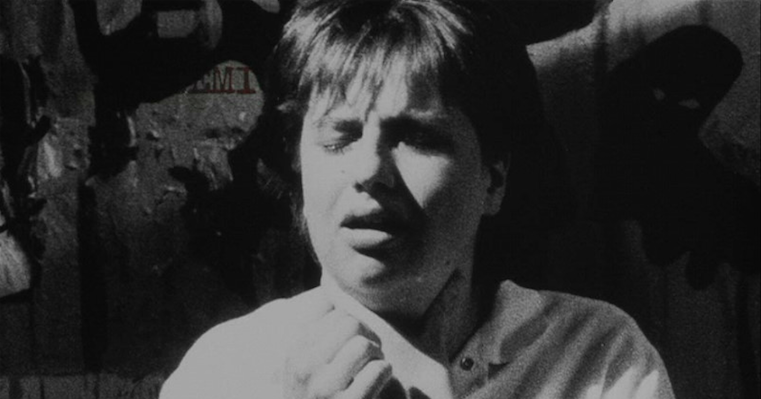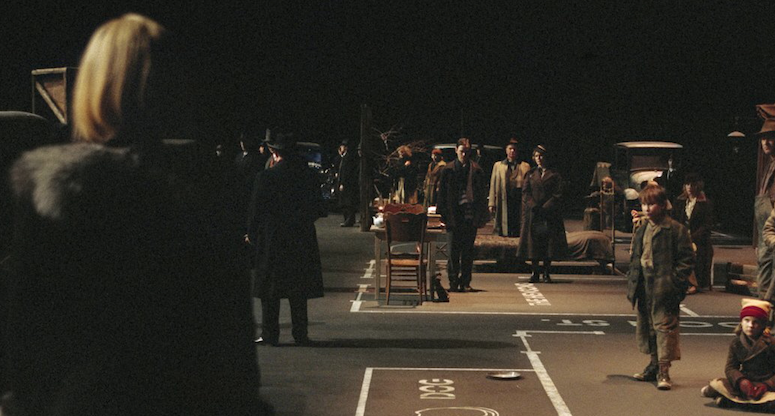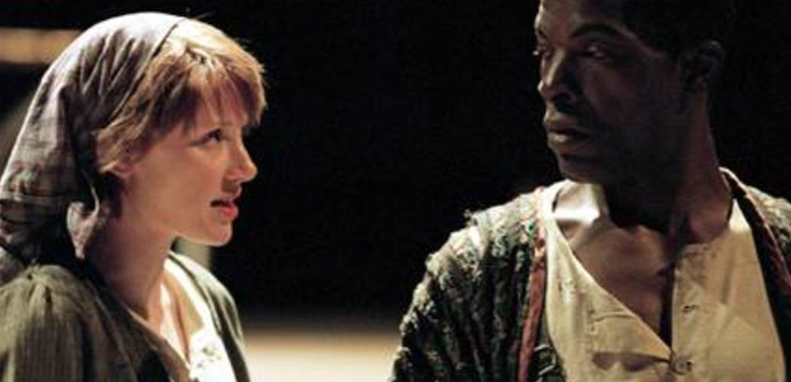There are very few provocateurs in the film biz these days, and of the ones that do exist, hardly any hold a candle to Lars von Trier’s consistently shocking, daring, extraordinary filmography. Originally one of the founders of the Dogme-95 movement of avant-garde filmmaking that originated in Denmark, Von Trier began to break away from his origins and evolve in sometimes difficult-to-watch, yet always compelling ways. With his newest film, the uncompromising, five-hour, two-part Nymphomaniac (or: Nymph()maniac, according to the ads) coming to select theaters after hitting Video On-Demand, the Movie Mezzanine team thought it would be a good time to look back at the intransigent auteur’s filmography; from his Dogme 95 days, to his boldly experimental work, and his recent pop-art-house films. Without further ado: the films of Lars von Trier.
The Element of Crime (1984)
Von Trier’s first feature, The Element of Crime seems an anomaly amidst a filmography that now appears chiefly concerned with exorcising deeply disturbing personal demons. It may be the director’s least personal film; like many first-time directors, von Trier finds self-expression in well-worn genre tropes. Stylistically brash and visually murky, The Element of Crime plays like a Nordic Blade Runner, with liberal borrowings from Terry Gilliam (nightmarish, decaying dystopia) and David Lynch (obtuse and labyrinthine storytelling). Von Trier’s stylistic overcompensation masks a rather simple story about a haunted detective hunting an enigmatic serial killer–hardly an original plotline. The Element of Crime is nowhere near von Trier’s best film (it could easily be his worst), but it’s worth seeking out for von Trier completists. Fans of strange sci-fi noir might enjoy it as a curiosity; however, all but the most trenchant von Trier fans will find it a baffling and ultimately unrewarding genre experiment. – Kristen Sales
Epidemic (1987)
While von Trier’s previous film The Element of Crime was drenched in a hypnotically honeyed sepia tone, his second feature Epidemic is shot in stark black and white. Von Trier and co-writer Niels Vørsel play screenwriters trying to write a movie at the last minute for a producer who needs a film right away. The resulting screenplay is Epidemic itself and all the sequences of the ‘film within a film’ bare a copyrighted ‘EPIDEMIC’ logo on the upper left of the frame. While this framing device comes across as pretty smart alec-y, the story itself is quite deadly serious. In the screenplay/film, von Trier (again and also) plays Dr. Mesmer, who travels from country to country trying to cure a widespread, global epidemic. This marks the second in von Trier’s “Europa” trilogy and the epidemic in question is clearly analogous to the continent-sweeping Black Death. That a highly infectious and fatal plague is used as a metaphor for the creative process is a typically wry and morbid joke from von Trier, who might well be considered the Andy Kaufman of auteurist provocateurs. Epidemic is dark and strange, beautifully photographed, replete with tangential asides and unexpected bursts of violence and death. It is unmistakably a Lars von Trier joint. – Sales
Europa (1991)
Before Lars von Trier was playing with the limitations of the Dogme 95 manifesto, and thereby attempting a jab at realism, realism seemed the furthest thing from the director’s mind during Europa. It’s a Kafka-esque nightmare, literally hypnotic as the voiceover by Max von Sydow lulls you to sleep. “You will be in Europa…” The final part of von Trier’s Dissolution of Europe Trilogy places the setting primarily on a train in an almost post-apocalyptic US-occupied Germany after World War II. Lars von Trier utilizes a postmodern aesthetic, mixing languages, spoken and filmic, to articulate a sheer sense of foreboding. Playing with archetypes of film noir like a child takes a magnifying glass to torture an ant hill, it’s as if Lars von Trier diabolically combined the romantic elements of Casablanca and the atmospheric ones of Double Indemnity. Europa was Lars von Trier’s third feature, a night train that boggles the mind and leaves an indelible mark on the psyche, proving that he was here to stay. – Kyle Turner
Breaking the Waves (1996)
Lars von Trier broke out as an international voice to be reckoned with when Breaking the Waves, his first fully English language film, debuted. Here is a film that begins in the vein of a classic Douglas Sirk melodrama, only to plunge further into more menacing depths. Starring Emily Watson in her breakout role (one that she still hasn’t been able to top), Breaking the Waves is more than just a painfully depressing love story, much like how Sirk and Fassbinder managed to imbue the romantic melodrama with sociological critique. Here, love and sex intertwine with faith and religion in fascinating, disturbing, sometimes darkly humorous, but often difficult-to-watch ways. As Watson’s Bess begins to believe that fulfilling her ailing husband’s sexual desires will divinely cure his paralysis, we bear witness to an innocent, human soul being torn apart by the seams. As negative as Von Trier’s stance on religious communities is, he never resorts to mocking Bess for her beliefs, even if she is brutally punished for them. The question of whether or not Von Trier takes joy in enduring his female protagonists through such insurmountable physical and psychological pain is often brought up, and while there may never be a definitive answer, Breaking the Waves suggests a warmth and beauty that not a lot of his other films display as prominently. – Christopher Runyon
The Idiots (1998)
The Idiots is famous for two things: First, its adherence to Lars von Trier’s and Thomas Vinterberg’s “dogme 95” aesthetic manifesto—a call to abandon props, extra lighting, and even directorial credit and to shoot low quality digital video as a way of rebelling against the bourgeois art that bourgeois society has created, and to combat the bourgeois perception of art. Second, its offensive story, in which characters pretend to be mentally challenged, “spassing” out in public as a way of refusing to participate in a society they feel is stifling their creativity. The counterhegemonic parallels in form and content are key to The Idiots, but by the end, the film arguably rejects the possibility of ever adhering to this “vow of chastity” in the manifesto despite simultaneously doing so. It’s no wonder, then, that Lars Von Trier is so often labeled a provocateur, as with The Idiots alone, he both laughs at those who take such ideas seriously and fully encourages you to do so. That is, he would do so, if you take the film to be his—but he remains uncredited. It’s precisely these contradictions that make The Idiots, love it or hate it, one of the most vital films of the 1990s. – Forrest Cardamenis
Dancer in The Dark (2000)
When Lars Von Trier released Dancer in the Dark, there was criticism that, having never been to America, he had no right to make the film. In fact, the opposite may be true, as Dancer in the Dark is a story about how the cultural output of a country—in this case, musicals—creates perceptions of a fantasy world, and how the real world crushes those hopes. But the film’s final act, beginning with a hilariously out-of-place and unbelievable court scene, abandons perceptions of nationalism and location to instead refocus on the mother-son dynamic and female martyrdom. That said, it’s the musical numbers, stylishly shot in opposition to the rest of the film’s dogme-recalling aesthetic, masterfully edited, and beautifully performed and scored by Bjork, that make the film memorable. Dancer may invite criticism of its politics by drawing attention to questions of capitalism vs. communism and the “American Dream” a bit too often, but more importantly, it is an affecting melodrama with musical numbers every bit as enchanting as those that influence its protagonist. – Cardamenis
The Five Obstructions (2003)
The Five Obstructions is an experimental documentary collaboration between von Trier and his mentor, film director Jorgen Leth. Von Trier challenges Leth to remake his 1967 film The Perfect Human five times, each time with a different restriction or caveat (obstruction). Like Epidemic, The Five Obstructions is a film about making a film, a self-conscious deconstruction of the process, the mystique of which von Trier seems determined to dismantle piece by piece. Von Trier’s impish delight at Leth’s increasing frustration is a highlight of the film, but as much as Lars comes off as sadistic troll, there’s a real genius behind this experiment. The Perfect Human is a non-narrative short that satirizes conformity and social mores by showcasing the “perfect” behavior for a series of everyday tasks: eating, sleeping, and so on. The lack of real-world context in Leth’s film is precisely what von Trier challenges by sending the director to film in the poorest area of India, or Cuba, or to remake his short as a cartoon. How “perfect” can anything be if it’s not real? The Five Obstructions is a perfect distillation of von Trier as media personality, as well as an insight to his creative impulses. – Sales
Dogville (2003)
A beautiful new stranger comes into town immediately followed by a swarm of black automobiles investigating the disappearance of a woman who might be in the area. Town philosopher Tom tells them he has seen no such person and sends them on their way. The stranger, Grace, asks for shelter in their town and Tom arranges a town meeting.
During the meeting Tom decides to put a theory to the test: if human beings are basically good they will allow someone to stay in their midst without distrust. The local residents are hesitant to grant her request, but Tom’s plan to have her do chores for the town to justify her staying sways them. Their civility doesn’t last long after a wanted poster is put up and authorities come around asking for Grace. Now with the town reassessing the cost of harboring Grace, she may find that Dogville’s teeth are going to be bared.
By filming Dogville on a sound stage, Lars Von Trier really enhances the claustrophobia that plagues Grace during her stay in Dogville. Von Trier has made more inflammatory works in Antichrist and Breaking the Waves, but Dogville‘s horrors comes from the decent, earnest, small-town folk who are only doing the best they can for a stranger. Now that is horrifying. – Colin Biggs
Manderlay (2005)
Manderlay (2005) is Lars von Trier’s sequel to the critically acclaimed and endlessly controversial Dogville (2003) and picks up exactly where that film left off. After destroying the town of Dogville, Grace (there, Nicole Kidman and here, Bryce Dallas Howard) discovers yet another singular community, Manderlay, a Southern plantation in which slavery still exists well into the 1930s. Grace then sets about “correcting” the perceived injustices of the plantation’s inhabitants. Like Dogville, its sequel is staged with minimalist set dressing and shot similarly to a play in which the physical landmarks of the plantation are replaced with their verbal signifiers. The relative critical failure of Manderlay in relation to Dogville may be the reason von Trier has yet to complete his “USA–Land of Opportunities” trilogy, which seems a shame considering the director obviously he has more to say about the subject. Perhaps the irony of a movie about a crusading, idealist outsider (Grace) fundamentally misunderstanding a deeply raw and painful aspect of American culture (slavery) proved too prescient even for a cinematic rabble-rouser like von Trier. – Sales
The Boss of it All (2006)
If you listen closely, somewhere, you can hear the sounds of Lars von Trier maniacally laughing his head off at… corporate America, probably. It isn’t really a secret that most of Lars von Trier’s films are imbued with his wicked, nearly devilish sense of humor, even in his most austere dramas, but The Boss of It All allowed him to make a full fledged comedy. Take one part The Hudsucker Proxy (by the Coen Brothers), one part The Office, one part Arrested Development, add a dash of formalist invention (the film used a process of cutting called Automavision ,which was controlled by a computer) have them all mixed together cooked by the enfant terrible of art cinema, and you get The Boss of It All. It seems airy and light for von Trier, especially given that it’s a bit more straightforward on its own, but the director doesn’t downplay the satirical nature of the film. Biting barbs against large corporations and hypocrisy elevate the film from a minor place in Lars von Trier’s filmography to an underrated gem. – Turner
Antichrist (2009)
Melancholia (2011)
For a director who’s been able to document different levels of despair, it’s a wonder that Von Trier finally got around to making a film that’s literally about clinical depression; but boy did he choose a method of doing so, as he turns this story of the numbing effects of hopelessness in the face of a dispassionate world into something we never really see: an art-house disaster film. The result is Melancholia, in which a giant planet bearing the namesake is on a crash course for earth all while two sisters, played beautifully by Charlotte Gainsbourg and Kirsten Dunst, are battling their own sorrows. Every other disaster movie uses the end of the world as the hypothetical endpoint of a situation to raise the stakes of the destruction. But Melancholia may be the only disaster movie I’ve ever seen in which you honestly feel inexplicable sadness for the world’s end. Whereas the woe of Von Trier’s other films were hard to watch and existentially crushing, Melancholia finds a sublimity in misery, seeing the futile nature of happiness as its own beauty – not just through its characters, but in Von Trier’s breathtaking depiction of destruction, turning the apocalypse into a classical art piece Rembrandt would’ve admired. In a way, that arguably makes Melancholia his definitive film. – Runyon
—

































2 thoughts on “The Lars von Trier Retrospective”
There is no filmmaker that means a lot to me more than Lars von Trier. I just love the fact that he isn’t afraid to play the bad guy and get away with it. BTW, where’s Medea and The Kingdom I & II?
Both were made for Danish TV, not theatrical. However, both Madea & Riget are personal favorites.